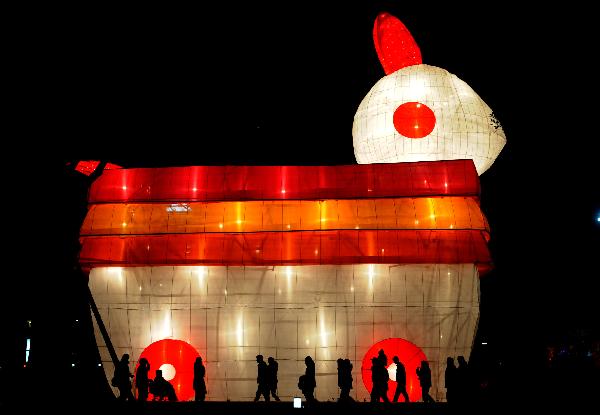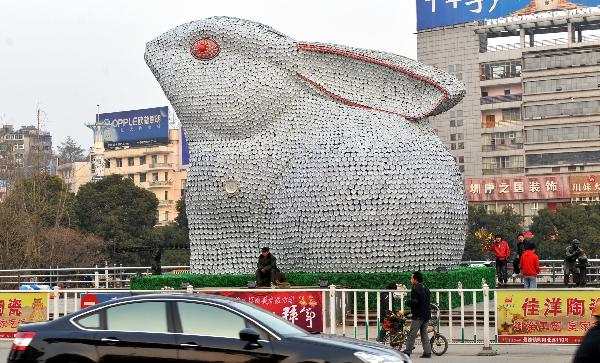 |
|
Tourists view a giant rabbit lantern at the spring lantern fair held in Lubo Park in Zhengzhou, capital of central China's Henan Province, Jan. 29, 2011. (Xinhua/Zhu Xiang) |
BEIJING, Jan. 29 (Xinhua) - If a Chinese, when greeting others, shows her or his hands folded with two thumbs straight up, don't be surprised. The year of rabbit is coming.
The gesture features a rabbit with two long ears.
The Chinese have a tradition to make a bow with hands held in fists during the traditional family reunion holiday to spread good luck to relatives and friends.
But the new gesture is welcomed by many young citizens in China. "It is more vivid and cute," said Qian Jia, a college student from Anhui Normal University.
As the Chinese lunar new year of the rabbit approaches, this winter China is embracing thousands of "rabbits", including diversified dolls with bunny images and special species of bunnies in pet shops.
Searching "Rabbit" on Taobao Mall, the largest online shopping website in China, there will be nearly 5 million results containing hundreds of products, from cartoon pictures, cloth puppets, various headwear such as hairpins and hats, to decorations such as lanterns and packets, all printed with rabbits.
One of the online sellers from east China's Zhejiang Province selling plush toys and other items such as cushions with the pattern of rabbits, has witnessed a sales record. The pink dolls, named "Love Rabbit", in four sizes with prices varying from 15.8 yuan to 48.7 yuan, had 11,911 orders for purchases within one month.
"Items associated with the rabbit began to sell well beginning last October," said a man surnamed Xia, who said his online store belonged to the Fengbao toy company in the manufacturing Yiwu city.
Among the 200 items sold in the store, about 40 were related to the rabbit. "These items accounted for half of the sales in the store," he said, adding that last year these items brought the company a profit of 150,000 yuan.
The bunny fervor also rejuvenated Chinese traditional art.
Ceramic rabbits are created in Jingdezhen, which is located in north China's Jiangxi Province and honored "the capital of china".
Students from a primary school in Shandong Province are taught to make dough figurines in the shape of rabbits, which is similar to old Chinese folk crafts.
One of the children, an eight-year-old girl, said "I felt proud when my teacher complimented me on my works".
Not only have the toy rabbits sprung up, but also the real animals are winning more and more favor from the young generations.
The pet market in Xi'an, capital city of northwest China's Shaanxi Province, has been turned into a paradise for rabbits.
The Dutch rabbits, with black and white fur resembling pandas, and the American fuzzy lop rabbits, which are featured with two drooping ears, are the "kings of popularity," said a vendor surnamed Liu at a local pet stall.
Compared with last year, sales of the two types of rabbits almost doubled, he said.
Prices of different sizes and models vary from 25 yuan to 280 yuan for each in Xi'an, with the possibility of prices still rising before the Spring Festival begins on Feb. 3.
The buyers are mostly college students and white-collar workers, who consider the rabbits to be the best gifts for their friends, Liu added.
At the railway station of Shijiazhuang, capital city of north China's Hebei Province, seven vendors attracted attention from passengers with their rabbits. One of them sold three, for 15 yuan each, within half an hour.
In the meanwhile, many residents have begun to raise rabbits, instead of cats and dogs, as their pets.
"They are more tame and clean, easier to look after," Wang Chun said.
The mother in Shijiazhuang hoped her 6-year old daughter, who was a bunny fan, would be filled with love and care by feeding a rabbit.
However, this perception is not shared by Shan Cong, who is an activist in animal protection and once kept a rabbit for six years.
She warns that rabbits need a dry and clean environment and are vulnerable to common diseases, like diarrhea and sniffles.
Animal protectionists are also against the trend of the commercialization of the rabbit.
"More rabbits will be abandoned and even eaten after a period when people's curiosity dies away," said Gao Jie, who founded an association of street cat protection in 2007.
Gu Zilin, a professor with the Hebei Agriculture University, who is an expert in feeding rabbits, warned that many rabbits sold by vendors would ultimately grow into adults and people should be cautious in choosing such pets.
"Many vendors claim that their rabbits would never grow bigger, but this is just not true," he said.
In order to strengthen people's awareness of protecting rabbits, an exhibition opening for adolescents was held in northeast China's Hei Longjiang Province, organized by the provincial museum.
"We have arranged some entertaining games and interactive activities for the young visitors, hoping that they could learn more about rabbits and show particular love and care for them," said Xiang Kunlong, a researcher from the museum.
In the Chinese Zodiac, each year is related to an animal. People born in the year of the "hare" are described as "kind, elegant and shy".
(One dollar equals about 6.6 yuan.)











